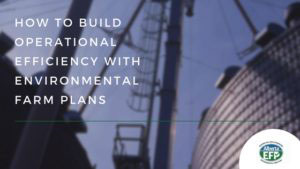Written by Paul Watson, Alberta EFP Director.

Environmental farm planning can help you improve your farm well beyond doing the right thing for the environment. The impacts can reach to all areas of your business from strategy and marketing to financial and operations. In this post consider that environmental farm planning can help you be more efficient, which can save time, money and in some cases, lives.
Human Resources
Safety - Environmental farm planning helps you to review the types, storage and use of inputs on the farm. Having an environmental farm plan in place helps you to think critically about how to use these items and gives everyone on the farm clear directions on what is appropriate and what is not.
Employee retention/recruitment - environmental stewardship has been a consistent trend over the last decade. Recruiting the labour and the next generation has been another trend as well. Having an environmental farm plan in place is one component of an employee recruitment strategy. Showing your farm cares about the community, can be a helpful branding message to new or current employees, even if they are your family.
Training - when you have an environmental farm plan, you have a training tool that those on the farm can gain an understanding of the operations as well as the context. Understanding the topography and how the operation interacts with that terrain is an excellent way to connect the new (or current) team to your operation.
Operations
Inputs - Environmental farm planning as mentioned above, helps you to review what you bring into your operation. Considering your inputs from this lens may give you insight on how you’re doing things and how you might be able to do things more efficiently. The apparent gain is financial. However, there can also be a time savings from ordering the inputs to seeding, feeding and harvest, all of which can impact how much time you save as well.
Waste - when an operation can mitigate, reduce or reuse its waste, it can often save time or money or both. Identifying and finding alternative ways to manage the flow of nutrients and resources on our farms can help us to manage the risks and the cash flow statement.
Upgrading/Maintaining Equipment - Keeping your equipment maintained can reduce the number of resources you use and in some cases, upgrading your equipment to environmentally-friendly options can reduce those resources to the point that they eventually can pay for themselves.
Energy and water use are both inputs worth reviewing. On many farms energy (electricity and fuel) use is a critical component of operations. Without it, much of our modern operations would come to a halt. Managing this risk can help reduce downtime, increase efficiency and help manage a major input cost. Water is also a critical component if you live on your farm, raise crops or animals.
Infrastructure - Identifying how you are using your infrastructure such as fencing, buildings, storage bins, fuel tanks can give you insight into whether you can be doing it better. Having a fresh perspective on how you are using your infrastructure (how your corrals are set up or where your fuel tanks are) may also help you save time and be more efficient.
You may find that using your environmental farm plan as part of reviewing your farm operations can be a useful document and a different perspective. This gives you an opportunity to update your environmental plan as well keeping your whole operation sustainable. With a new renewal period being introduced in the next year, you can give us your ideas on the best way to implement this change at our one-minute survey
 Initiative
Initiative